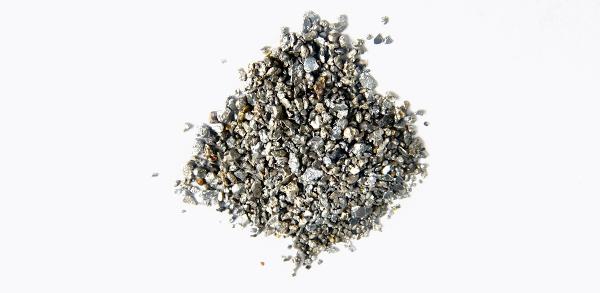O iridium It is a metal belonging to group 9 of Periodic table. Despite this, it is more commonly associated with the so-called platinum group metals, which involve, in addition to itself, the metals platinum, osmium, ruthenium, rhodium and palladium. Iridium is well known for its great resistance to corrosion, high density and low presence in the earth's crust.
It is a metal that has gained a lot of appreciation in recent years, being more expensive than gold, including. Its high melting point and good corrosion resistance make it an important agent in the manufacture of alloys, as well as in aircraft engine components. It was discovered in 1803 by Smithson Tennant, along with osmium.
Read too:Cobalt — another metal belonging to group 9 of the Periodic Table
Topics of this article
- 1 - Summary about iridium
- 2 - Properties of iridium
- 3 - Characteristics of iridium
- 4 - Where can iridium be found?
- 5 - Obtaining iridium
- 6 - Applications of iridium
- 7 - History of iridium
Iridium Summary
Iridium, symbol Ir and atomic number 77,
it's a metal hard, brittle, highly resistant to corrosion, high melting and boiling points, in addition to low reactivity.It is a metal of low presence in the Earth's crust and of high density.
It is more present in asteroids than on our planet.
It is known that iridium was one of the constituents of the asteroid that extinguished the dinosaurs.
It belongs to the group known as platinum group metals, along with rhodium, osmium, ruthenium, palladium, and platinum.
It occurs in association with other platinum group metals, but is also obtained as a by-product of nickel production.
It is used in the manufacture of engine parts, spark plugs, catalysts, among others.
It is valued, with a higher price than gold.
It was discovered in 1803 by Smithson Tennat.
Do not stop now... There's more after the publicity ;)
iridium properties
Symbol: Go.
Atomic number: 77.
Atomic mass: 192.217 a.u.u.a.
Electronegativity: 2,2.
Fusion point: 2446 °C.
Boiling point: 4428 °C.
Density: 22.562 g.cm-3 (20°C).
Electronic configuration: [Xe] 6s2 4f14 5d7.
chemical series: metals, group 9, platinum group metals, transition elements.
Iridium characteristics

Iridium is a silver metal, but with a slightly yellowish tint. É quite hard and brittle, being very difficult to mold or work with. It is the second densest element in the Periodic Table, second only to Osmium (Os), which has a few hundred more density. É belonging to the group known as platinum group metals (PGM), along with platinum (Pt), palladium (Pd), rhodium (Rd), osmium (Os) and ruthenium (Ru).
What calls attention in the chemical behavior of iridium is its low reactivity, being considered the most corrosion-resistant metal known. Its reaction with oxygen gas and halogens only occurs at high temperatures, and it is even resistant to aqua regia, a mixture of concentrated nitric and hydrochloric acids. Only in bases and some molten salts is it able to be dissolved.
Although the +3 and +4 oxidation states are the most common for iridium, research has managed to isolate the compound [IrO4]+, in which the metal reaches the oxidation number +9, the element with the widest possible range of oxidation states (from -3 to +9).
Where can iridium be found?

Iridium is a rare metal in the earth's crust, and its abundance is 40 times smaller than that of gold. It is suspected that, due to its great affinity with iron (a property known as siderophilia), it was deposited in deeper layers of the planet during its formation.
is an element very present, however, in asteroids. Incredibly, iridium is linked to one of the greatest catastrophes in the history of our planet, which occurred about 65 million years ago, the extinction of the Cretaceous-Paleogene (K-Pg), responsible for the loss of approximately 70% of plant and animal species on our planet, including dinosaurs not flying.
The geological marker of K-Pg contains a thin layer with very high concentrations of iridium, much higher than the concentrations in the crust. This was a strong indication that Luis Alvarez and his group of researchers pointed to to claim that dinosaurs would have been extinct because of an asteroid.
Incidentally, it is understood that much of the iridium present today on our planet comes from this asteroid. In terms of ores, iridium Occurs in all platinum ores. However, it is in osmiridium and iridosmine ores that, associated with osmium metal, iridium has a higher mass concentration (up to 80%).
Obtaining iridium
Obtaining iridium is similar to that of the other platinum group metals, as these metals occur together and must be separated. The main way is by solvent extraction and therefore use of ion exchange resins. It is also possible to obtain iridium as by-product of nickel production (Ni).
The main producers of iridium are Russia and South Africa. The African country, by the way, has one of the largest natural reserves of platinum group metals, thanks to the Bushveld Igneous Complex, whose iridium reserves are around 280 tons.
Iridium applications
Iridium, due to its great resistance to corrosion, has already been used in manufacture of standard meter bar, consisting of 90% platinum and 10% iridium, replaced in 1960 by the spectral line of krypton isotope 86 (Kr).
It is a metal that can be used for making of metal alloys, as in the IrOs alloy, is applied in the manufacture of pen tips. In addition to corrosion resistance, Ir is well known for its thermal resistance and, therefore, is also used in manufacture of automotive engine components and spark plugs, which — despite being more expensive — are recognized for greater durability and quality.

However, in recent years, iridium has gained greater value. In 2021, its price reached an incredible $6,000 per ounce (about 28 grams). In addition to the scarcity of its supply, iridium is a candidate for hydrogen production.
It has great use as catalyst in hydrogenation processes in the chemical industry. Still taking advantage of its catalytic profile, iridium (like other platinum group metals) is used in automotive catalysts.
See too: Titanium — another metal known for its great resistance to corrosion
history of iridium
The iridium It was discovered along with osmium in 1803 by the British chemist Smithson Tennant., born in the year 1761. Tennant studied Medicine, but after graduation, he decided to dedicate himself to studying Chemistry when he realized that, due to his temperament, he would not be suited to the practice of Medicine.
At the age of 23, despite not having published any scientific articles, the British was elected as a partner of the Royal Society. Even so, despite few subsequent scientific publications, Tennant left significant contributions, such as the study that concluded that diamond was made only of diamond.
In the case of iridium (and hence osmium), Tennant made his discovery through black insoluble impurities of platinum ores treated with aqua regia. He treated them with caustic soda (NaOH) before performing an extraction with hydrochloric acid (HCl), which was repeated several times.
From this he obtained red crystals, probably Na2[IrCl6].nH2O, which, when heated, gave a white powder. Tennant commented that such a powder was not capable of being melted by any level of heat he could apply.
The element was named iridium in honor of Iris, messenger of the Greek gods and the personification of rainbow in mythology, because of the variety of colors the metal could have in acid solutions hydrochloric.
By Stefano Araujo Novais
Chemistry teacher
Learn more about cobalt metal. Learn about its physicochemical properties, applications, extraction methods, history, characteristics and care.
Learn more about platinum, as well as its characteristics, properties, applications, curiosities, obtaining and history.
Have you ever heard of the chemical element ruthenium? Click here and find out about its characteristics, properties, ways of obtaining it, applications and history.
Have you ever heard of the chemical element osmium? Click here and find out about its characteristics, properties, ways of obtaining it, applications and history.


